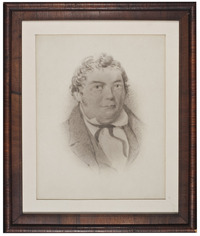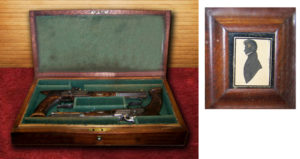To honour Richmond’s 200th anniversary, we will be posting factoids about our rich history. Over the next year you should expect to see 200 pieces of information that you may or may not have already known. The topic of these posts are: #36. A satirical poem #37. The 1830s #38. The Last Duel #39 The first Church & its rectory #40 the Mallochs and interpretation of Factoid #36
If you have a question about the source of a factoid please contact us.

Dictionary of Canadian Biography
Factoid #36. Said to be the work of either Hamnett Pinhey (leader of the March elite) or Dr. A.J. Christie (editor and publisher of the Bytown Gazette), the satirical poem entitled “The Carleton Election or the Tale of A Bytown Ram” showed the disdain felt by the March elite towards the Richmond leaders. The electors of the District of Bathurst must certainly have been amused by this epic poem in 10 cantos published in 1832. Here are the opening lines. Can you identify these Richmond characters?
“In murky mood assembled Richmond’s gentry,
The widow what’s her name was placed as sentry,
The traiterous lynx-ey’d Louis in the chair,
And Molock too (the papers say) was there;
And Burke was there, not Dan the body-snatcher,
Nor was it John the North West rat-catcher,
But George it was, who, with but small reflection,
Drew out the plan for carrying the Election;
Milo was there I think the papers say,
Maxwell I’m told, so was Fagerty,
And Georgium Sidus with his ambling pen
Was voted Secretary in the Lion’s den.”
Our identification of the characters will be found at the end of factoid #40.
Factoid #37. In the early 1820s Richmond was a boomtown. Growth was everywhere and Richmond people dominated the local economic and political scene. There was a slight dip in the population after 1822 as some farmers looked for better conditions elsewhere. The beginning of Rideau Canal provided jobs and business opportunities but with the completion of the canal and the development of Bytown the focus moved to the east. The merchants and tradesmen who had flocked to Richmond in order to make money saw the volume of business decrease and their profits fall. Slowly the economic powerhouse migrated. Some went north and west looking for new frontiers; others moved 20 miles east to booming Bytown. More importantly many who left were the young and ambitious.
On the political scene, the old elite managed to maintain its influence. The military officers John Lewis and George Lyon retained the loyalty of the soldier/settlers. Lyon and George Burke still had contacts within the old bureaucracy in York and knew how to get land patents and patronage for the area. As leaders of the militia they were able to rally support against the reformers and the Rebellion of 1837. But the writing was on the wall when Richmond lost the campaign to be the site of a new County jail. The jail would have rejuvenated the economy but instead the new building was placed in Bytown. Even Edward Malloch, the one civilian among the Richmond elite moved to Bytown.
The period was marked by infighting among the Tories. George Lyon and John Lewis competed with each other for political office and became involved in a bitter dispute. Lewis led a group of parishioners who petitioned to have the Anglican priest, Lyon’s brother in law, removed from office. But the 1830s were not without distinctive personalities and new accomplishments.

perthremembers .com
Factoid #38. The Last Duel. In 1829, 17-year-old Robert Lyon accompanied his sister Margaret to start a new life in Canada. After spending some time with his brother, George, in Richmond, Robert began an apprenticeship in the law office of George’s brother-in-law, Thomas Radenhurst.
In Perth, Robert became friendly with John Wilson who worked in the office of another lawyer, John Bolton. Apparently Lyon said disparaging words about a friend of Wilson who told others of Lyon’s remarks. Lyon called Wilson a “lying scoundral” and hit him. As the son of a farmer, Wilson felt he must assert himself or his new place in society would be in jeopardy. Wilson challenged Lyon to a duel.
On a rainy June day in 1833, the two young men and their seconds faced each other in a ploughed field outside Perth. Both men missed their first shot. Lyon’s second, Henry Le Leivre, insisted they fire again. Although considered to be the better shot, Lyon was killed. Le Leivre ran away but Wilson and his second surrendered. All three were charged with “wilful murder”. The Rev. William Bell wrote in his Journal “The excitement which the news of these things produced was indescribable”.
In August 1833 a jury found Wilson and his second not guilty but the event was a tragedy for all concerned. This event is considered to be “The Last Duel” in Canada, to have ended in death.
You can learn more in an article by James McTavish http://www.richmondheritage.ca/index.php/wilson-lyon-duel/
A different perspective is provided in the Journal of the Rev. William Bell, which is reproduced in Reid, Richard M. ed. The Upper Ottawa Valley to 1855. P 50-51.
Factoid # 39. In 1822 when the military stopped supporting the Richmond Settlement, Richmond had no churches. The Anglicans, Roman Catholics, Presbyterians and Methodists held services in the schoolhouse. The ex soldiers were used to having officers conduct services. Captain Joseph Maxwell would lead prayers. Another officer, Major Sewell Ormsby was a Justice of the Peace and magistrate. He was known to marry couples in the Richmond Arms Hotel but he appears to have been unsure about the legality of the marriages and encouraged couples to redo the ceremony when a clergyman was available.
The military had promised the settlers an Episcopal (Anglican) church but none had been built. In February 1823 George Burke joined other community leaders in petitioning the government to fulfill its promise. In June the corner stone for St. John the Baptist Church was laid and a log shell erected. (This was probably behind the present church and facing Royal York St.) The church went unfinished and a visiting missionary in 1828 reported that services were still being held in the schoolhouse. The church was finally completed and was consecrated by the bishop in 1836.
At the same time the parish benefited from turmoil in the politics of Upper Canada. The Anglicans had long received income from the Clergy Reserve lands and the government attempted to solidify the support of what it considered to be its most loyal supporters. The Anglicans were given finances for the creation of Crown Rectories. St. John’s was one of the original 40 established in Upper Canada. A fine one and a half storey stone house was constructed beside the log church and facing Fowler St. Even as late as 1850 it was one of only three stone dwellings in the village and the only one not also a commercial building. So one had the situation of a new stone rectory placed beside an old log church. How this changed is a story for another day.
Factoid #40. In 1818 as the Richmond bound women and children camped on the banks of the Ottawa River a young enthusiastic girl delighted the tired group. Margaret, daughter of Andrew and Maria Hill moved on to the village. Ten years later she married a young Scotsman, Edward Malloch. He was well educated and highly motivated to be a successful merchant. From his Richmond store he made a great deal of money providing supplies to both settlers and the builders of the Rideau Canal. In the late 1830s the Mallochs moved from Richmond to the booming Bytown.
Malloch soon turned to land speculation and over time bought at least 8000 acres of land and 5100 acres in Loyalists rights. He had the reputation as being ruthless in his business dealings and bought and sold blocks of land in Richmond as well as Bytown and rural Carleton County.
Edward was the first non-military veteran to be admitted to the Richmond political elite and served as a member of various Legislatures from 1834 to 1852. He became county Sherriff and helped finance a militia.
After Edward’s death in 1867 Margaret continued his business and did not hesitate to make investments particularly by acquiring mortgages. For example in 1869 she lent more than $5000 for the building of a macadamized road from Bytown to Gloucester and quickly recouped her investment. In Richmond she constantly showed her generosity towards her old friends. She offered free land for the building of a new town hall and sold land to the Presbyterian congregation for a new manse on McBean St. for one dollar.
Margaret and Edward owned the land on which George Brown built his stately stone store (at the northwest corner of McBean and Strachan Streets) and then Margaret owned the building after 1869. She was a Richmonite who did not forget her roots.
MY INTERPRETATION OF FACTOID # 36: 1. The widow = Maria Hill 2. “The traitorous lynx-ey’d Louis” = Captain John Lewis who Pinhey felt had betrayed him 3. Mallock= Edward Malloch 4. Burke = Col. George T. Burke 5. Milo = George Burke’s brother 6. “Fagerty” = Philip Fogarty (the Burke and Fogarty famililies were interrelated and had been close for years) George Burke’s son-in-law 7. “Georgium Sidus … Secretary in the Lion’s den” = Captain George Lyon.
